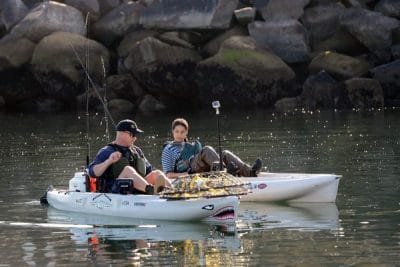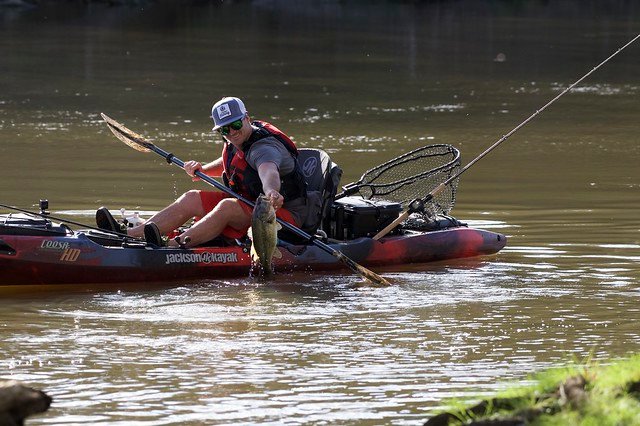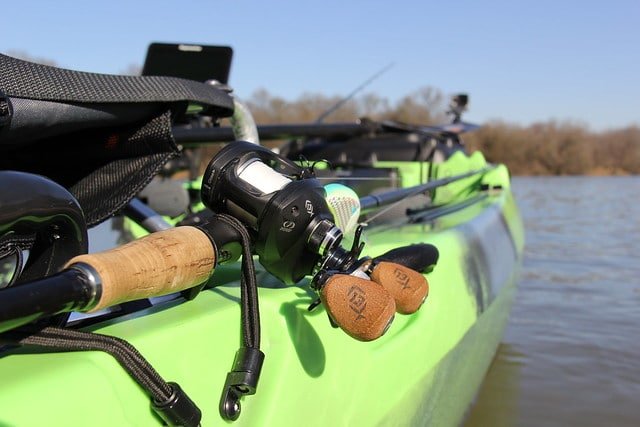The lake was fishing slow that day. The hot weather had made the bass lethargic and they snubbed their nose at anything in my tackle box.
I knew that connected by a shallow, narrow creek was another lake south of me. It had deeper water and good shade. There was nowhere to launch a boat on that lake and it was several miles from a road so the only people who fished there had to traverse this tiny creek.
It had been a dry summer and I knew the creek would either be shallow, or empty. I paddled out to where the creek began and was happy to see some water laying in it.
With the sun beginning to set I started to paddle down. The creek was dry in some spots, but in others held water no deeper than 7” and was no wider than 5’.
I pulled my kayak through the shallow water and dry bed before reaching the end of the creek where the water covered my knees. I began to drift down and emerged into a lake, no larger than 50 acres.
I gave a cast to the front of the pads and slowly retrieved the frog back towards me.
I had caught few small fish in deep water, but with the sun beginning to set my attention turned towards a set of lily pads in the far corner. Hoping I could catch a few on a frog, I paddled over.
I gave a few more casts to the pads, hopeful each time but nothing took. The sun moved behind the trees now. Unfortunately, night fishing was not going to be an option, so if I was going to catch something it would have to be soon.
Slowly, I drifted down the long line of pads, careful not to make much noise for fear of spooking any fish.
I noticed a tree laying in the water, the lily pads nestled around it. A lofting cast landed the frog an inch up on the muddy bank.
Easing it into the water I gave it a few pops before an explosion beneath took it under. A swift hookset followed.
The braid on my reel began to whine as the fish started to take drag. It dove down and was tangled in the branches of the fallen tree. I kept pressure on the line hopeful that it would free itself, but no such luck.
Keeping tension, I paddled over and drifted over top of the tree. My line was shooting straight down into the pads but there was no visual on the fish.
I placed my rod in the holder, and decided to hop in, hoping it was still hooked. I slid over the side of the kayak and felt the cool water warm my sunburnt legs and feet.
Underneath, I didn’t see the fish but was able to make out the yellow belly of the frog indicating where it was stuck.
I thought, “Even if I lost the fish at least I get my lure back.”
The water was only five feet or so, which meant I was able to stand and dunk my head under. Reaching down to grab the lure the branch began to move and I knew the fish was still hooked.
I was able to lip the bass and slide the frog from its mouth.
I brought my head above water and lifted up the fish. Bringing it over to the kayak I clipped the scale onto the lip of the bass — 4.2lbs… not a trophy, but it was worth getting a little damp over!
Table of contents
Why Start Kayak Fishing?
You start kayak fishing for stories like the one above. You wouldn’t be able to fit a bass boat down that narrow of a creek channel, and if you decided to take your truck and trailer off-roading, you’ll find no boat ramp.
When you have something that can traverse shallow water like a kayak, then your fishing opportunities will begin to dramatically open up.
And if you have a limited storage space or a budget, then a kayak might be the way to go. You can find them reasonably cheap at flea markets or garage sales. Because of their size, they are much easier to store than a large bass boat.
If you’re really limited on storage space you could even look into inflatable kayaks. They deflate and can store anywhere you need it.
Benefits of Kayak Fishing
There are so many different types of kayak that can be utilized. If you prefer to fish saltwater or the great lakes then you’ll find that companies make kayaks specifically for rougher water.
If you want to piddle around on a small local lake or a farm pond then you can do that as well.
If you do decide to purchase a larger kayak for fishing on big lakes or saltwater just know that those are normally a pricier option compared to the smaller 9’ kayak that you can take out on skinny water.
If you’re like most fisherman you’ll be using this to fish local lakes and rivers. With kayaks you can fish these waters successfully. The real gem of using a kayak is how accessible they are to different bodies of water.
If you’re out fishing a low river and get to a dry spot before it gets deep again, you don’t need to turn the boat around and head home. Instead you can paddle up to it, get out and pull your kayak until you’ve reached water deep enough for you to paddle in.
Same with traversing small connecting waterways between different lakes and rivers. There would be no story of me jumping in to grab a fish if I was out in a bass boat. Instead I navigated through the skinny shallow water and was spat out into a nice deep lake.
Kayaks also have the capability to hold any equipment you might need for the day. They have areas large enough for coolers, tackle boxes, and plenty of nooks and crannies to store gear.
Where Can You Fish in a Kayak?
Pretty much everywhere except for crabbing in the Bering Sea!
A good saltwater kayak can handle the surf and strong waters of the ocean, river, or lake.
Basically, you’re only limited to where you go based off of what kind of kayak you choose to purchase.
A shorter, cheaper kayak can handle shallow and calm waters with ease, but would have trouble anywhere waves are present.
In general, you can go pretty much anywhere and do anything with your kayak. It’s truly a great asset to your fishing arsenal.
How To Get Started
Before you head out to the lake there are a few things you need in order to get started.
Picking out your fishing kayak
This is going to vary depending on where you’re fishing, what type of fish you’re going for, and how much gear you have. Same goes for what your budget would be as well as any space constraints in terms of storage.
Saltwater
Saltwater kayaks are going to the largest and most expensive kayak you can purchase. However, these are made to have incredible balance and can stand up to the rough ocean waters.
They also come equipped with large areas for gear storage and because of their larger bodies have ample room to add different accessories such as rod holders, sonar units, and anything in between.
Saltwater kayaks can also be used effectively on large rivers as well as the great lakes.
They can be used on smaller bodies of water but navigating small creeks could be tricky.
Freshwater
Typically smaller than your saltwater brethren, these can be used effectively on smaller pieces of water such as navigating small creeks.
On these you will have plenty of room to hold your fishing essentials for the day as well as a few other smaller items.
They’re not as big but they’re large enough that you can utilize the space for rod holder, wade stick, or anything else that you might desire.
Gear Storage
This all depends on what you’re looking to bring along with you.
Many anglers are total and complete gear junkies. They need to have the latest and greatest lure, paddle, sonar, tackle box, cooler, what have you. But there are some that are minimalist. They take along exactly what they need and nothing more.
So, when selecting your kayak take into account what kind of fisherman am I? Do I need to bring along every piece of fishing equipment I own, or am I confident in these few lures, a pair pliers, and a rod?
They make kayaks for all different types of gear heads. You just need to shop around and see which one would be the best for you.
Price
This is all dependent on how much you’re willing to spend.
You can find a cheap used kayak from a garage sale for close to or less than $50.
A cheap new one could run you around $150-200.
These are typically going to be bare bones and won’t have much gear storage capabilities. These are also typically sit in kayaks as well. You can still fish out of them but they won’t have the same stability as a sit on top, which you can actually stand on.
A new sit on top kayak can run you anywhere from $400 all the way up to $2,000 or more. The more expensive ones will typically be bigger with better stability and more areas to store all of your gear.
How To Set Up Your Kayak
If you’re a bare bones angler then you could easily take it straight from the store to the water. No muss, no fuss.
However, kayaks can be customizable as well. The seats can be switched out for something that sits a little bit higher so you have a better vantage point and could make it easier to stand. They also make padded and back support seats for extra comfort.
Not all kayaks will come equipped with a rod holder so you may need to install these yourself. You could also install a series of rod holders that you could use as a spider rig for crappie fishing.
Rod holders typically just need to be clipped onto the side while some may need to be drilled into the boat.
I also recommend that you have something to cradle your paddle when casting. This is great when you want to drift along and cast without having to worry about your paddle sitting in your lap and banging around.
An easy set up is to tie some paracord around your paddle and connect the cord to a handle or anywhere else you kayak that has a loop on it. Now when you cast you can let you paddle float in the water and when you want to move again you can pull it in.
You can also set up sonar on your kayak as well. This may take a little bit of rigging in order to get it sitting just right, but you can easily drill in the mounting bracket and be using sonar on your kayak shortly.
Kayak Fishing Must Haves
All you really need is a paddle, a rod, and a reel. However, there are many different items that can make your day of kayak fishing easier.
Utilizing the front or back of the kayak for proper tackle storage is a huge asset. If organized properly you can keep anything you want in there in order to be ready for anything.
Having at least 2 rod holders can be of great benefit.
You can easily hold two rods while paddling out to your spot and have two different lures tied onto each of them. This works great when you have a fish hit your first lure and miss and then you can whip around and grab your second rod and cast out to the same spot to attempt to catch the fish.
Also, using sonar is a great way to really learn the lake or river you’re fishing. It can really help on bodies of water that you may not be very familiar with. With this equipment you’d be able to see exactly where structure and bait fish are which can help stay on top of fish all day.
Kayak Fishing Tips
There are several different ways that you can fish from a kayak.
- You can set up a spider rig system and you can troll for crappie or other panfish.
- If you have a sit on top which will allow you to stand you could easily fly fish from one as well.
- Fly fishing from a sit in can be done but it’s usually a little cumbersome
- On top of this you can also use the traditional cast and retrieve method using either you spinning rod or your baitcaster.
- Sight fishing can be done as well, especially during the bass spawn. However, it would help to have a kayak that has the stability to allow you to stand. This way you’re able to drift along the banks and you’ll be able to easily spot the beds that the bass have created.
There are two things that are of great benefit to a kayak angler — that is a rod holder and a paddle holder.
Having to lean your paddle on top of your kayak while trying to cast could lead to it falling into the water, or banging it around and spooking any fish in the area.
And attempting to paddle to a spot with rods on your lap is a good way for them to wind up in the bottom of the lake.
Having both a rod and paddle holder is preferred, but a rod holder should be the first thing you put on your fishing kayak.
Kayak Fishing FAQ’s
How to choose a fishing kayak?
This all depends on your personal needs as well as your budget. You need to take into account what type of water you’re going to be fishing, what your price range is, and how much space do you have at your home to stow it.
If you’re living in a small apartment in the city then an inflatable kayak might be your best bet.
For additional guidance, you can check out the article I wrote here to help in your decision: https://boardandkayaklife.com/sit-in-vs-sit-on-top-kayak-fishing/
What clothing should I wear for kayak fishing?
I’m starting to sound a little bit like a broken record, but again, it depends.
What time of the year are you going to be fishing?
If you enjoy cold weather fishing then something that is waterproof and is warm is going to be your best bet.
If you’re fishing a spring morning that might be chilly, you’ll need to bring along a light jacket. Long pants might be required, but by mid-day those can be shed into a t-shirt and shorts if need be.
If it’s the middle of summer and you need something to keep you cool and protect you from the sun then any sort of sun shirt or lightweight pants will be effective.
Basically, you don’t want to be wearing anything too cumbersome as you need to have the freedom move around and paddle your kayak.
Also you should be wearing something that is waterproof or something that you don’t mind getting wet.
Is kayak fishing dangerous?
Any activity done in the water has the potential to be dangerous. If you’re not careful you could seriously hurt yourself or worse.
However, if you take the proper precautions, such as not fishing during inclement weather or rough water, as well as wearing your PFD then it is a perfectly safe and fun activity.
What kind of rod and reel is most effective for kayak fishing?
Any of them!
As long as you’re out on the water and enjoying yourself then it doesn’t matter what you want to use. I wouldn’t recommend using a heavy surf rod to catch crappie but, hey, to each their own.
Final Thoughts
Kayak fishing is a great way to get out on the water and enjoy some time in the great outdoors.
Not only is it a fun and relaxing way to get outside but it’s also great exercise as well. Paddling around a lake all day is no small feat and if you do it consistently, you’ll see the results.
Kayak fishing can be a lifelong hobby. You can easily start when you’re young and can continue doing so into old age.








I fell for kayak fishing from approx 2 years now, and its indeed the beauty of the journey… come across manything but the excitement of kayak fishing never overtaken by another, thanks for sharing the expert it would super useful for beginner, keep up the good work!
Yep, it’s a whole different world if you’ve never tried it before. But be careful, once you try it you might never fish from a boat again!